|
Rising
alcohol levels in wine:
Are they a problem, and what
can be done about them?
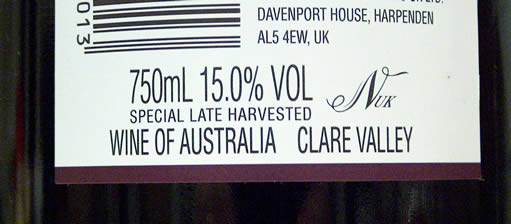
As I’ve said before, wine gets you drunk. It’s
because wine is an alcoholic drink. This sounds like a rather
facile statement, but it’s something we can forget in our
high-end, anoraky discussions about first growths, super seconds
and Grand Cru Burgundies. It’s part of the point of wine,
isn’t it? That’s why it’s the social drug of choice in
western countries.
Now, after being relatively ignored by the wine trade,
the subject of wine’s alcoholic content is currently a hot
topic. This is because there’s increasing concern about the
trend of rising alcoholic levels. Table wines used to hover around
the 12% mark: now it’s rare to find them below 13%, and wines
with 14 or 14.5% alcohol are commonly encountered. And it’s not
all that unusual to see wines tipping the scales at 15%. This
feature takes a broad-perspective look at this topic, asking why
it is that these rising alcohol levels are a concern, and then
looking at what can be done about them.
The
basics
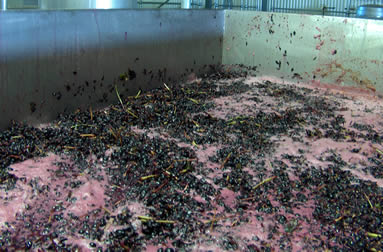 Alcohol is produced by the fermentation of sugars by
yeast, and so it follows that the higher the sugar level in the
grapes, the higher the final alcohol level in the wine when it is
fermented to dryness. Sugar accumulates in grapes during the
ripening process, being produced by the process of photosynthesis
in the leaves and stems of the grapevine. Alcohol is produced by the fermentation of sugars by
yeast, and so it follows that the higher the sugar level in the
grapes, the higher the final alcohol level in the wine when it is
fermented to dryness. Sugar accumulates in grapes during the
ripening process, being produced by the process of photosynthesis
in the leaves and stems of the grapevine.
The rate of photosynthesis is determined by the
intensity and duration of light, plus the ambient temperature, in
a rather complex relationship. In brief, photosynthesis is
maximized in warm, sunny conditions where there is lots of light
and the elevated temperatures cause chemical reactions to occur at
a faster rate, but if it is too hot, photosynthesis stops because
the vine closes its stomata (gas exchange pores) to reduce water
loss. Thus we can have a situation where in hot regions,
development lags behind warm regions because photosynthesis will
have ceased during the warmest hours of the day.
The
ripening process
Conceptually, it helps to distinguish two distinct
ripening processes in grapes. I should add that this is perhaps a
slightly simplistic dichotomy that is disputed by some, but I
think it serves a useful conceptual purpose.
- Sugar
ripeness: as the grapes mature, the sugar levels rise and the
acid levels decrease.
- Phenolic
or physiological ripeness: changes in tannins, reduction in
methoxypyrazine levels, leading to ‘flavour ripeness’.
In cool climates, the physiological ripeness precedes
sugar ripeness. Indeed, throughout much of Europe, the only
measurement required as harvest time comes round is the level of
sugar in the grapes. Once this reaches a certain level, you can
assume that the grapes are ripe. And in many regions, the addition
of sugar to the must in a process known as chaptalization is
carried out because full sugar ripeness hasn’t been achieved.
Acid levels are commonly quite high at harvest in cool climates.
In ideal climates the two ripenesses intersect:
physiological maturity is reached at a sensible sugar level, where
the acidity is also at the appropriate level.
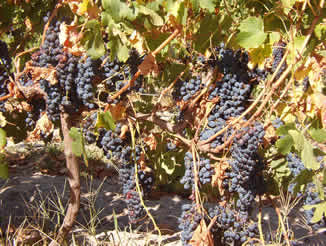 In warm climates, physiological ripeness frequently
trails sugar ripeness. Thus winemakers who wait for physiological
ripeness often have to contend with high sugar and thus high
alcohol levels, and need to acidify, too. Generally speaking, a
lack of physiological ripeness is more detrimental to wine quality
than a lack of sugar ripeness: it’s much easier to correct for a
lack of sugar ripeness than it is to correct for a lack of
physiological ripeness. This is because many of the compounds
involved in physiological ripeness are antifeedants: the
green-tasting methoxypyrazines and bitter tannins are presumably
intended to make immature grapes unpalatable to birds. They
decrease as the grape matures, to the point where the vine is
ready to let the birds to take the grapes to propagate the seeds. In warm climates, physiological ripeness frequently
trails sugar ripeness. Thus winemakers who wait for physiological
ripeness often have to contend with high sugar and thus high
alcohol levels, and need to acidify, too. Generally speaking, a
lack of physiological ripeness is more detrimental to wine quality
than a lack of sugar ripeness: it’s much easier to correct for a
lack of sugar ripeness than it is to correct for a lack of
physiological ripeness. This is because many of the compounds
involved in physiological ripeness are antifeedants: the
green-tasting methoxypyrazines and bitter tannins are presumably
intended to make immature grapes unpalatable to birds. They
decrease as the grape matures, to the point where the vine is
ready to let the birds to take the grapes to propagate the seeds.
Sugar levels can also increase by desiccation, where
the grapes lose water, concentrating both sugar and acidity. This
is dubbed ‘saggy grape syndrome’, because of the way that the
skins begin to pucker.
In recent years there has been more of an emphasis on
achieving flavour/physiological/sugar ripeness through later
picking. This is where we encounter the phenomenon known as
‘hang time’. Where harvest occurs in the autumn, picking
decisions are often influenced by weather concerns: the grapes are
brought in before the autumn rains. In warmer climates with
settled harvest weather, the grapes can be left as long as needed:
the temptation is to pick late, allowing what is known as ‘hang
time’. It is controversial, because changes occur to the tannic
structure and the fruit profile, which, in its most extreme
incarnation results in wines that show ‘dead fruit’.
Why
have alcohol levels increased in recent years?
There are a number of explanations for elevated alcohol levels in
wine, although we don’t have enough data to separate them.
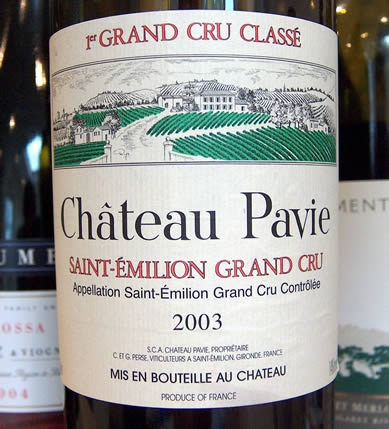 1. Global warming: data show that over the last 50
years average temperatures in most wine regions have risen
noticeably. Warmer growing seasons usually result in riper grapes
with higher sugar levels. 1. Global warming: data show that over the last 50
years average temperatures in most wine regions have risen
noticeably. Warmer growing seasons usually result in riper grapes
with higher sugar levels.
2. Improved viticulture has led to grapes being picked
in a riper state than they were before.
3. Stylistic changes: winemakers have opted for later
picking to produce wines with sweeter fruit profiles, made in an
‘international’ style.
One explanation that has been touted is that modern
strains of yeast are more efficient at converting sugar into wine,
but this proposed improved yeast efficiency is probably not a
reason for higher alcohol, simply because there is no evidence
that the yeasts use today are any more efficient than those that
used to be used. The conversion factor has remained pretty stable.
Why
are increased alcohol levels a cause for concern?
The least concerning aspect of rising alcohol levels is the
increase in alcoholic content itself: after all, it’s easy
enough just to drink a little less of the wine.
The main concern is the effect of high alcohol on the
sensory properties of the wine. Relatively small changes in
alcohol content can have quite a strong influence on how the other
components of the wine are perceived. I find I don’t really
enjoy wines with higher alcohol as much because of the effects of
the alcohol on the nose of the wine, and the bitter/sweet/salty
character the alcohol lends to the palate. Yes, I do enjoy Port,
which has 20% alcohol, but there, allied to higher alcohol levels,
we also have sweetness.
The other significant concern surrounds issues of
‘style’ or ‘taste’. Decisions about when to pick have
quite an influence on how the wine will come out. In recent years
there has been critical influence, largely from the USA, pushing
red wines (in particular) towards a homogenized
‘international’ style. I realize this statement could form the
basis of a feature all on its own, but for now, I’m tempted just
to say that red wines showing higher levels of ripe fruit,
accompanied by softer tannins and plenty of new oak influence
often get very high scores from the leading critics, whose ratings
then influence sales, most notably in the USA where critical
scores have a strong effect on sales. When grapes are picked late
to achieve this style, and lots of new oak is employed in the
elevage, the sense of place (or terroir) of a wine is often
masked. Wines ending up tasting similar no matter where they have
come from. [Yes, this is a controversial assertion that needs
backing up with examples – but this will have to be done some
other time, perhaps in another feature.]
What
can be done about it?
There are three approaches to deal with higher must sugar levels,
leading potentially to higher alcohol in the final wine.
- In the winery: alcohol reduction
- In the vineyard: viticultural interventions and decision-making
- For the future: yeast development
Alcohol
reduction
The first approach is to remove alcohol from the wine
after fermentation. Three methods are currently used of which only
two are legal: reverse osmosis and the spinning cone. The third is
the addition of water to the must, which isn’t allowed but is
practiced quite widely in warmer regions.
Reverse osmosis is a filtration device that employs a
technique known as cross-flow filtration. Rather than direct the
flow of liquid at a filter, which results in the filter gradually
becoming blocked with the filtrate, the flow of liquid is in
parallel with the filter membrane, and thus the flow itself keeps
the membrane free of blockage. So a counter current filter will
look like a long tube, with the walls being made out of the filter
membrane. As the liquid passes through the tube, it is filtered,
but a much larger membrane surface is clearly needed with this
technique.
Reverse osmosis takes water, alcohol and other small
molecules out of the wine, the alcohol is taken out by
distillation, and then the water is recombined back with the wine
to make a low alcohol wine which can then be used for blending
with untreated wine to produce a final wine with precisely
determined alcoholic content. Other variations on this theme
exist. Many wineries have their own reverse osmosis machine;
others get this done on a contract basis.
The spinning cone is a bit more complicated. It
separates off the volatile components from the wine which are then
fractionated. The important bits are kept and the alcohol is
selectively removed. Because this machine is big, the winery has
to send the wine to a contract facility for treatment. The end
result – a wine with a reduced alcoholic content – is the
same.
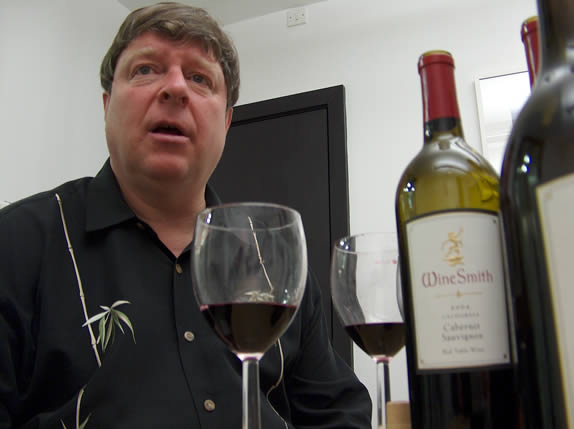 There’s a concept worth mentioning here: that of the
sweetspot. The notion is that if you line up glasses of the same
alcohol-adjusted wine at a range of alcohol concentrations, say
from 12 to 15% at 0.1% increments, some will work much better than
others. The same wine may have a sweetspot at 12.8, another at
13.2 and another at 14.1, as if you were tuning into
radiostations. For more on this, see an
interview I did with Clark Smith (pictured right), whose
company, Vinovation, specializes in fine-tuning the alcohol levels
of wine. There’s a concept worth mentioning here: that of the
sweetspot. The notion is that if you line up glasses of the same
alcohol-adjusted wine at a range of alcohol concentrations, say
from 12 to 15% at 0.1% increments, some will work much better than
others. The same wine may have a sweetspot at 12.8, another at
13.2 and another at 14.1, as if you were tuning into
radiostations. For more on this, see an
interview I did with Clark Smith (pictured right), whose
company, Vinovation, specializes in fine-tuning the alcohol levels
of wine.
There seem to be gains and losses associated with the
use of such technologies, and the balance between the two seems to
depend on who you talk to. On the plus side, many wines show much
better with reduced alcohol levels. On the negative side, these
sorts of treatments are quite physical, and may beat the wine up a
bit. It’s hard to debate the subject in a relative absence of
good, independent data.
Vineyard
intervention
It is hard, but not impossible, to make changes in the vineyard to
try to get grapes fully physiologically ripe without sky high
sugar levels. Of course, the first question that needs to be asked
is whether just picking earlier might work. Growers don’t want
grapes that have green, unripe flavours, but it could be argued
that some are currently picking later than they need to. Again,
this gets back to the style issue that we have already discussed.
Any vineyard intervention that achieves more
homogeneous ripening is going to help. If the various patches of a
vineyard are ripening at different rates, then picking may be
occurring later than is ideal for some bits, as growers wait for
late-ripening bits to ripen while other bits are over-ripe with
desiccated, raisined berries in some bunches that just add sugar
and little else to the must. Green harvesting the latest bunches
to go through veraison is a useful intervention, as is identifying
and understanding the natural variation that occurs within the
vineyard.
If irrigation is present, this can be used as a tool
towards the end of ripening to help control sugar levels in
grapes. Sometimes adding a bit of water before harvest can be a
good thing, because it may buy a few more days for flavour
ripeness to complete while offsetting the natural rise in sugar
concentration that would otherwise occur during this period.
Organic/biodynamic viticulture may help, although this
is a large, complex subject that can’t be done justice in this
context. I’ve heard quite a few growers report that since they
shifted to an organic regime that had at its core the use of
compost to build up organic material in the soil, they’ve found
it easier to get ripeness at sensible sugar levels. It may also be
that manual tilling of the soil encourages the vine roots to sink
deeper, from where they are able to extract a slow but steady
supply of water during the period preceding ripening.
The canopy is likely to be important here. Leaves are
the factories that, through photosynthesis, produce sugar. Growers
need a canopy that is appropriate for the crop they are planning
to take. Sometimes a 6 foot wall of wines might have just too much
photosynthetic power for a small crop.
Factors such as row spacing, vine density, pruning
decisions, canopy height, fruit shading, and water availability
will combine together to influence the vine’s physiology when it
comes to ripening the crop. There are a lot of variables that need
to be understood and manipulated where possible.
Yeast
development
The final tool that could potentially be used in the war against
high alcohol is the organism responsible for making alcohol in the
first place, the alcogenous yeast Saccharomyces cerevisiae.
Yeasts produce alcohol from metabolizing sugar. If by selective
breeding or genetic modification we can get yeasts to use a
different metabolic pathway, one that, for example metabolizes
sugar to glycerol, then the yield of alcohol per gram of sugar
will be less. There are currently a number of projects looking at
this possibility, and it may well be that in five years time
yeasts will be on the market with a lower conversion factor. But
this is currently some way from being a practical option.
In conclusion, along with much of the trade, I consider
the rising alcohol levels in wine to be a bit of a problem, and
one that needs addressing. It’s perhaps unfortunate that many of
the potential solutions are so manipulative in nature, at a time
when the naturalness of wine is an issue coming under increasing
public scrutiny. I have a general guiding principle when it comes
to winegrowing: if you are going to intervene, the earlier you
intervene in the winegrowing process the better. Thus I feel that
of all the solutions to high alcohol offered here in this brief
review, the most promising is the set of vineyard interventions
that may well help in producing fully ripe grapes at lower sugar
levels.
Article published December 2007
Back to top
|

